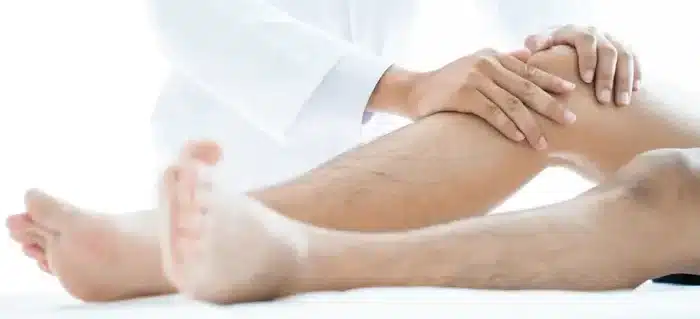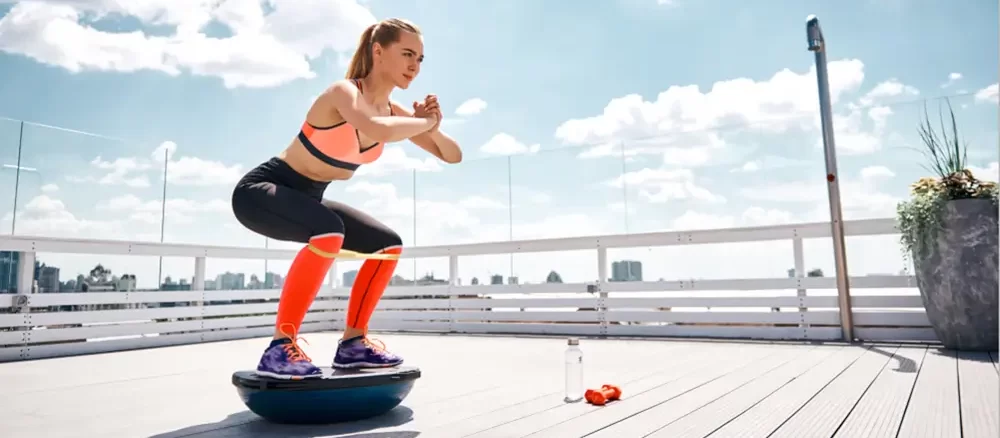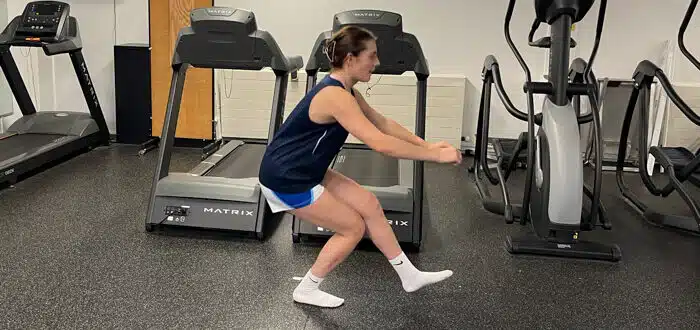
6 trainingswetten voor een succesvol herstel na een knieoperatie
If you have had knee surgery but continue to have knee pain or your strength is not improving, there may be a good explanation for this. Muscles do not get stronger on their own. Are you exercising or training and do you follow the laws of training? This blog is about the training laws that everyone faces during knee rehabilitation. We offer tips and advice and provide valuable insights to get the most out of your recovery.
Discipline, regularity and perseverance
If you have had anterior cruciate ligament surgery, a knee replacement, or other knee surgery, it takes regular and intensive exercise to get the muscles strong again. You've probably asked yourself at times: why am I not progressing?
That knee rehabilitation takes a long time will probably be confirmed by every rehabber. Everyone will also confirm that the course of recovery is not linear, but with ups and downs. Two steps forward and one step back is typical of this process. A relapse cannot always be prevented, but having some knowledge about training, muscle building and nutrition can (maybe) make the difference. In this blog, you'll get tips to reduce the chances of a relapse in your knee rehabilitation, get answers to the question why am I not getting stronger and learn the 6 training laws for good knee rehabilitation.
The 6 training laws knee rehabilitation are:
- Specificity: you get better at what you are training. So the exercises should match your training goal.
- Overload: the intensity of the workout should be the same or heavier than the previous workout.
- Progression: training and recovery (work and rest ratio) must be aligned to make sufficient progress.
- Reduced increase output: building muscle strength and fitness is slower over time.
- Reversibility: accumulated muscle strength and fitness decrease (gradually) once the intensity and volume of training goes down.
- Supercompensation: after a workout and sufficient rest, the body will recover and be (slightly) stronger than the previous workout.
Wil je meer lezen over deze trainningswetten dan kan dat here.
Make sure your knee rehabilitation meets these 6 training laws. In addition to these training laws, it is also relevant to have certain knowledge of human biology regarding tissue repair and wound healing. These also affect what type of exercises you can do.
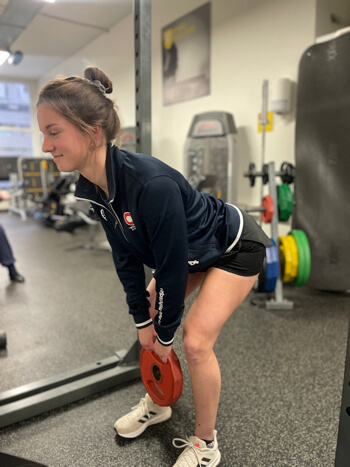
The 4 stages of recovery
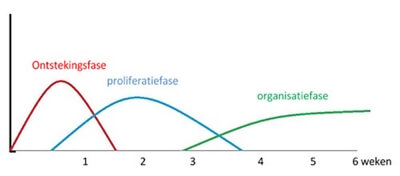
De fases van herstel
Immediately after knee surgery
No matter what knee surgery you had, everyone goes through the same stage of recovery. Of course, the extensiveness of the surgery affects the amount of reaction from the body (think: swelling, pain, redness and temperature increase). After surgery, the knee is swollen, stiff with bending and stretching, and muscle control and strength is decreased. The body must work hard to recover.
Start of your knee rehabilitation
The condition as well as muscle strength decreases rapidly after surgery due to inactivity, swelling and pain. This is the hallmark of the law reversibility. Everything built up over the years disappears because it is not used. By training regularly (2-3 times a week) and building up the intensity, the strength and condition of the body will increase again. Important focal points here are overload and progression, so that after a period of rest (24-48 hours) supercompensation occurs and you become stronger for the next workout.
Overload
When building up and loading the damaged tissue, the tensile force on the tissue must be taken into account. The new tissue is getting stronger by the week, so the intensity with strength training can gradually increase. If you build up the strength too quickly and do not give the body enough rest, the new tissue can be damaged again. Dosing load to load capacity is an ongoing process in all phases of connective tissue repair.
But why am I not getting stronger?
The simple answer is that training does not comply with training laws. In reality, the answer is more complicated. In addition to the training laws and phase of tissue recovery, altered physiology and disruptions to the neuromotor system must also be taken into account.
Physiological and neuromotor changes are:
- Verstoorde spiercontrole
- Spier dominantie
- Verstoorde reflexen
- Reflex atrofie (afname spierkracht)
- Visuele dominantie
- Afname van knie beweeglijkheid
- Verstoorde circulatie
- Toename van pijn, zwelling, stijfheid en afname van kracht.
It is important to recognize and anticipate these factors in your knee rehabilitation. Easier said than done. Your physical therapist can help you with this.
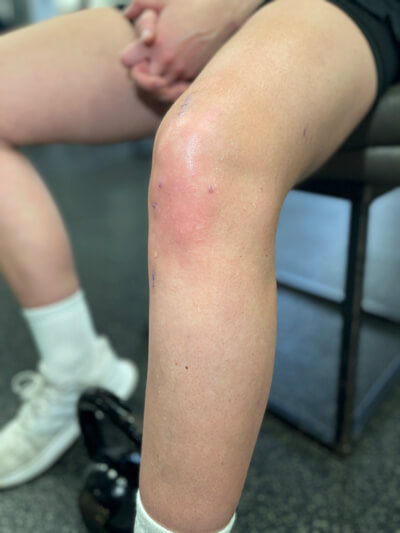
5 practical tips for improving your training
Train regularly (reversibility)
It's a clue, but exercising regularly stimulates muscles and fitness and increases your strength. Yet it is not easy to keep regularity due to motivation, vacation, illness, work, test weeks or other reasons. Normally after a week of not exercising, you don't notice much of this. During knee rehabilitation, however, the effect of not exercising is great. Decrease in strength and even a setback with increasing pain symptoms is often reported. Even if you continue to train on vacation, people notice when they return that their strength has decreased. People are surprised that they have muscle soreness again after the first workout. This is due to the following point.
Provide sufficient intensity and training scope (overload)
If you are used to training 1.5 hours (magnitude) at a certain intensity, then this is the baseline. Each workout should be about the same or higher than the baseline to maintain and/or further build the strength built up.
If you have vacation plans, then you know what to do. But vacation isn't called vacation for nothing. In practice, it is difficult to continue training at the same volume and intensity during the vacations. Training twice a week is often possible, but the lack of intensity causes the accumulated strength to decrease. This effect is often noticeable within a week. So don't take too long off, or make good plans with your physical therapist.
Muscle dominance or improper muscle control
Surgery on the knee always affects the muscle system. The muscles immediately around the knee experience the greatest changes. The operated knee also ultimately affects the entire movement chain. In short, people move differently.
Muscle tightening is difficult. The coordination between muscles when making movements is disturbed. Certain muscles suddenly become dominant whereas previously they supported movement. A recognizable muscle-dominant movement pattern is when the glutes and hamstring start working harder than the quadriceps femoris (thigh muscles) when stretching the body. This is called a hip dominant movement pattern versus a knee dominant movement pattern. In rehabilitation, it is important to recognize this pattern. If you are not careful, you can train heavier but the thigh muscles will not get stronger (the glutes and hamstring will do the work). This is a common problem in knee rehabilitation and this is characteristic of a hip dominant movement pattern. This picture is recognizable in open chain exercises and can be assessed with force measurements (e.g., biodex).
Can you exercise with knee pain?
Pain is annoying and (disturbs) knee rehabilitation. It is one of the factors contributing to disturbed movement patterns and muscle dominance, as described above. Therefore, it is a common reason that building strength is difficult. Pain causes reflex inhibition, which means that muscles temporarily do nothing. Especially the quadriceps femoris (thigh muscles) suffer from this and this is the muscle that needs to be strengthened. So it is not wise or useful to train in pain or through pain. However, a little discomfort or sensitivity is not a bad thing, and in consultation with your physical therapist, make a plan.
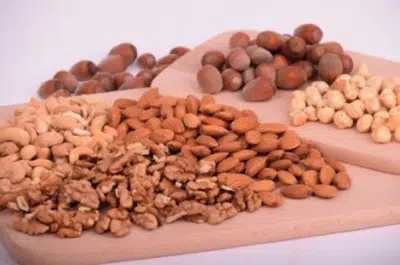
What to eat or not eat in knee rehabilitation
It may not be the first thing you think of, but nutrition plays an essential role in building muscle strength. Eat healthy and make sure you get enough protein intake. Insufficient recovery from training and slow or no building of muscle strength can be linked to insufficient protein intake. Roughly speaking, for muscle growth you want to get 1.5 to 2 times your body weight in protein. If you weigh 80 kilograms, you want to get 120 to 160 grams of protein in a day. Divide this intake over several meals. A tip is to eat at least 20 grams of protein within half an hour after a workout. The amount of protein intake does depend on the degree of exercise and body composition. For personal advice on nutrition, contact a dietician.
Furthermore, it is good to be aware that after anterior cruciate ligament surgery, knee replacement or other knee surgery, energy requirements are low in the initial phase. Do not eat too much and watch your intake of carbohydrates and fats.
In this blog read more about protein and knee rehabilitation.
Adhere to the 6 training laws to make your knee rehabilitation a success.
Building muscle strength in knee rehabilitation cannot be taken for granted. Training laws must be met, tissue recovery and altered physiology taken into account. Recovery takes a long time and it is good to know what you need to comply with to make your rehabilitation a success. Take the above tips to heart and possibly discuss them with your physical therapist the moment you get stuck or are not making enough progress.
If you have any other tips of your own, leave them in the comments.



